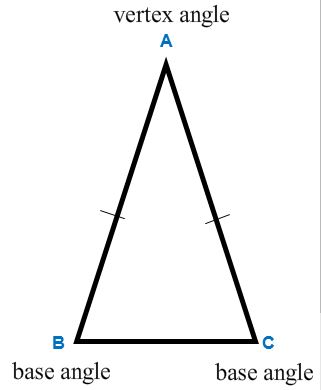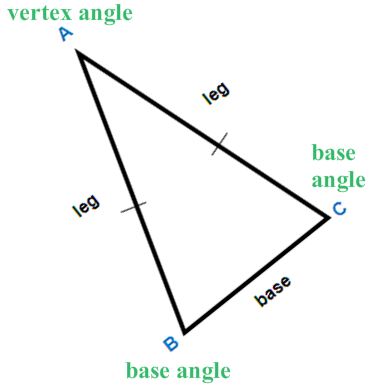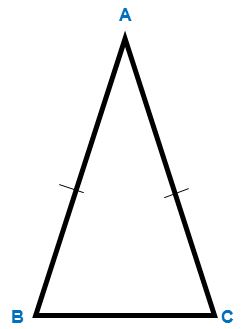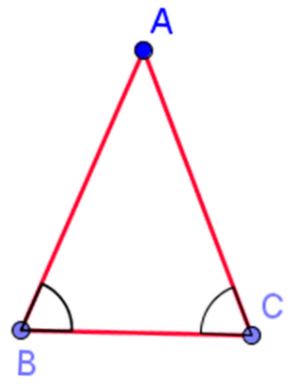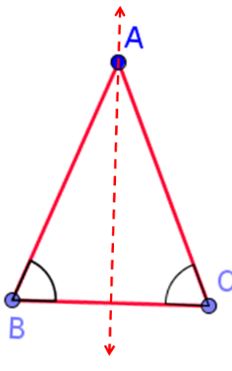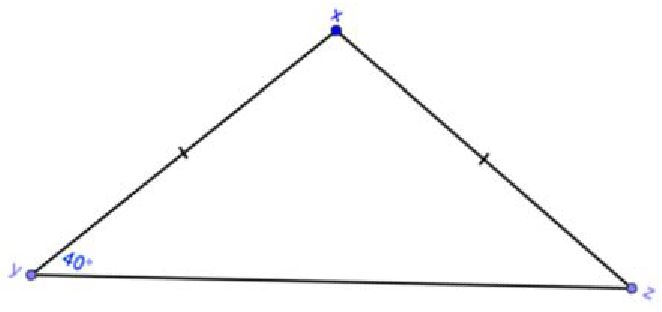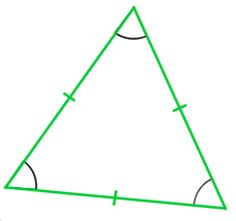Isosceles and Equilateral Triangles
Remember that in the previous lesson we learned how to classify triangles. We will look closer at these two triangles:
- Isosceles Triangles
- Equilateral Triangles
Vocabulary:
- Leg
- Base
- Vertex Angle
- Base Angle
- Base Angle Theorem
- Isosceles Triangle
- Equilateral Triangle
- Equiangular Triangle
- Corollary
- Transformations
- Reflection
- Rotation
Isosceles Triangles
First we will focus on the properties associated with isosceles triangles. Below are characteristics of an isosceles triangle. The congruent sides are called the legs and the other side is the base.
∠A is the vertex angle
∠B and ∠C are called the base angles
Please note that an isosceles triangle does not have to be sitting on its base. It can be rotated. It would not change the parts of the triangle.
Base Angles Theorem
Here is a theorem associated with isosceles triangles. Base angles theorem states that if two sides of a triangle are congruent, then the angles opposite them (called base angles) are congruent. If ∠AB ≅ ∠AC, then ∠B ≅ ∠C To find out more, go to Geogebra - Base Angles.
Converse to Base Angles
The converse is also true.
Converse to Base Angles theorem states that if a triangle has two congruent angles, then the sides opposite them are congruent.
If ∠B ≅ ∠C, then ∠AB ≅ ∠AC
Transformation
Recall that a line of symmetry is a line that when a figure is folded about the line the figure will land on itself. Could you draw a line of symmetry for the isosceles triangle to the right?
When the line of symmetry is drawn, notice how angles B and C would land on each other when the triangle is folded about the line of symmetry.
Thus an isoscles triangle has a reflection that will carry onto itself.
Recall that a rotation is when you turn the figure.
Could you rotate the isosceles triangle so that the rotation carries onto itself?
Yes or No?
Answer: No
Example #1
Find the missing angle measures x and z in the following triangle.
Solution: Since two sides are congruent we know the triangle is isosceles. Using the base angles theorem if two sides of a triangle are congruent, then the angles opposite them (called base angles) are congruent. we know that angles y and z are congruent, so angle z = 40°. The sume of all angles in a triangle is 180°, therefore we can use the following equation to solve for angle x.
x + y + z = ___°
Answer: 180°
x + ___ + ___ = 180°
Answer: x + 40 + 40 = 180°
x + ___ = 180°
Answer: x + 80 = 180°
x = ___°
Answer: x = 100°
Your Turn
You try one using the converse base angles theorem. Find the missing side length CD.
Let's start by reviewing the converse to the base angles theorem. if a triangle has two congruent angles, then the sides opposite them are congruent. What does it state? If a triangle has two congruent angles, then the sides opposite them are _________?
Answer: congruent
You try one using the converse to the base angles theorem. Find the missing side length CD.
Now you know that DE and CD are congruent. Using that information, what is the length of CD? ___
Answer: 7
Corollary
A result based on the base angles theorem called a corollary states that if a triangle is equilateral all sides have equal length , then it is equiangular all angles equal measure 60° .
The converse to that corollary states that if a triangle is equiangular, then the triangle is equilateral.
In other words, if a triangle has three congruent angles, it has three congruent sides. If it has three congruent sides, then it has three congruent angles.
Example #2
Find the missing angle measures.
Solution: Since all sides are congruent we know the triangle is equilatteral. The corollary states that an equilateral triangle is also equiangular. Since each angle is the same we can use x as the variable for each. Our equation will be as follows:
x + x + x = ___°
Answer: 180°
___ = 180°
Answer: 3x
x = ___°
Answer: 60°
Hence, each angle is 60°, no matter what the length of a leg is.
Translations?
Recall that a line of symmetry is a line that when folded about the line the figure will land on itself.
Could you draw a line of symmetry for the equilateral triangle to the right?
- Yes
- No
Answer: Yes
Is there more than one line of symmetry?
- Yes
- No
Answer: Yes
How many lines of symmetry?
- 1
- 2
- 3
Answer: 3
Could you rotate the triangle onto itself?
- Yes
- No
Answer: Yes

